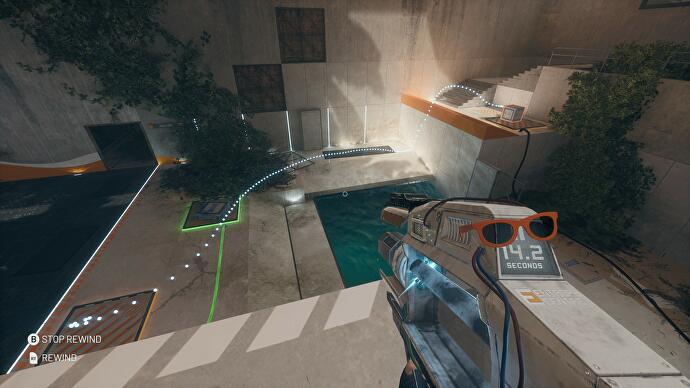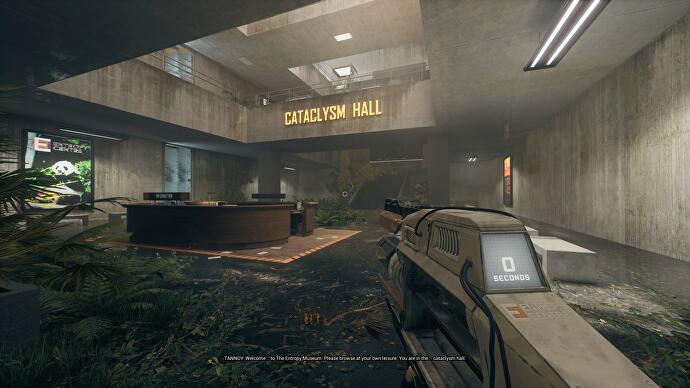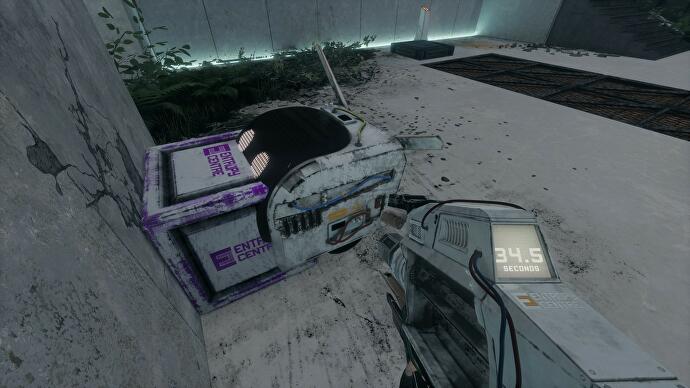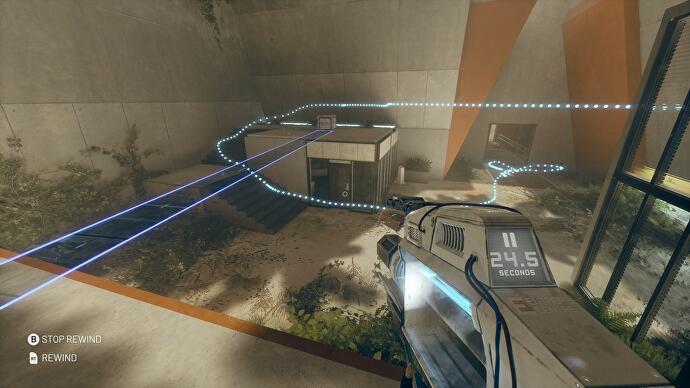The Entropy Center – Test: So now I know what happens when you bring Portal and Tenet together

Well, who knows? You wake up between gray concrete walls, receive a device that turns known physics on its head and place knee-high cubes on buttons in such a way that the exit to the next room opens. Logical: This is strikingly reminiscent of Portal, because The Entropy Center not only copied the rough concept from it, but also its gray concrete walls and a speaking AI that speaks up every now and then.
Of course, you are in the shoes of another protagonist – Aria, to be precise, who wakes up unaware of her task and her surroundings. It’s all the better that she soon finds ASTRA: the device that not only talks to her, but also allows her to move individual objects back through time. To do this, she aims at the appropriate object from any distance and keeps the trigger pressed. It’s already moving… usually it’s just a cube… backwards on the path on which it was previously carried somewhere.

For the simplest case, imagine a door on such a high level that you can’t just jump up it. However, an elevator goes there, which is triggered via a button on the floor. A second button right next to it opens the door. So the question is how do you get the cube on the door opener, since you put it on the elevator button to go up. Well, you put it on the door opener first, then move it to the second surface to take the elevator up, and from there drag it back in time to the button that opens the door.
What is all this for? Apparently, the eponymous entropy center built on the moon only generates energy for its central engine when such puzzles are solved. And the central machine can do exactly what ASTRA can do: turn back time – only on a much larger scale. Which is crucial when the earth is struck by an apocalyptic event. The goal here is to prevent that.
If you want to find out more about the entropy center, its history and the people who work there, you read short e-mails on computers that are sometimes hidden. However, as in Portal, the main focus is on working through consecutive puzzle rooms in a straight line. However, I don’t know from the original that many of the puzzles are repeated quite often, and it gets a little tiring in the long run. A tighter program, also in terms of the location that looks almost the same everywhere, would have provided more variety and motivation.

Of course, new elements will be added soon and later: treadmills, for example, or cubes with laser barriers and jump fields that you can also lift and move. There are also scenes in which Aria doesn’t move her cubes in peace, but has to straighten up falling pillars or scaffolding. And sometimes she even does that on the run as a space collapses around her. There is sometimes frustrating trial and error involved, but basically these real-time passages are good for the general rhythm.
Rather, I find it unfortunate that the cubes “fly” through all other objects – elevators or massive platforms – as soon as you move them back, because that somewhat undermines the illusion of experiencing a real physical phenomenon. There are even projectiles that hit you through walls. It’s also a pity that ASTRA can only interact with a few objects. Especially when turning back time, it would be cool if you could experiment with a larger number of objects from time to time.
I even find it really annoying that some solutions are suggested when certain elements are newly introduced. In any case, I already had the solution ready several times and was happy to play the system against itself, so to speak – only to be bumped into it straight away by the tutorial. It’s a shame The Entropy Center doesn’t give its players a little more credit and reward such ingenuity.

You still have to unravel a few pleasantly tricky brain knots. Real brain smoke is limited and is added a bit too late overall. But the principle itself is always so captivating that I never got bored. I have a lot of fun with headbutts, in which you have to move different cubes back and forth several times in a row.
Holding them over the edge of a platform to later rewind their time there so they fall off of there when time grip is disabled is cool. And then there’s the rewinding of falling paths while on the shards, because it kind of pushes you up from backward time. Could Christopher Nolan have been inspired by an early version of this game?
By the way, if you want to experiment with the space-time structure on the go, you can do so, because The Entropy Cente runs on the Steam Deck and, thanks to cloud save support, shares the saves with other versions of the same account. However, you should be satisfied with 40 second frames and very important: Set the Foliage Quality to the lowest value. Then you can even turn all other settings to Ultra.

I would have wished that the initial acceleration with small movements of the crosshairs would be significantly lower, because if you prefer relatively fast turning, it is often difficult to aim at distant boxes. And one more thing: Please give me the opportunity to turn off subtitles and rumble! It is quite annoying to hold a permanent vibrator in your hands when the time reversal is activated.
The Entropy Center Review: Conclusion
So this clever time game doesn’t quite fill in the footsteps of the role model Portal. Most of the puzzles lack the decisive piece of ingenuity, the physics lack the necessary consistency and many tasks are very similar. Last but not least, the rather silly ASTRA is a long way from the snappy charm of a GLaDOS. In return, The Entropy Center is one of those games where not only cracking a head nut is fun, but also interacting in itself. It is pleasantly intricate brain teaser about an extremely attractive principle, which is also cleverly embedded in an entertaining story. Anyone who likes to think around the corner (and back) should therefore be on the right track.
The Entropy Center – Score: 7/10
Pros and cons
Pros:
- Cool principle as the central mechanism
- Lots of tricky puzzles
- Real-time sequences occasionally add momentum
- Unsurprising but interesting story about time manipulation
Cons:
- Lots of repetition on puzzles and scenery
- Manipulated objects move through others
- Slightly inaccurate gamepad aiming with sensitive controls
- No free experimentation
![]()
Reference-www.eurogamer.de